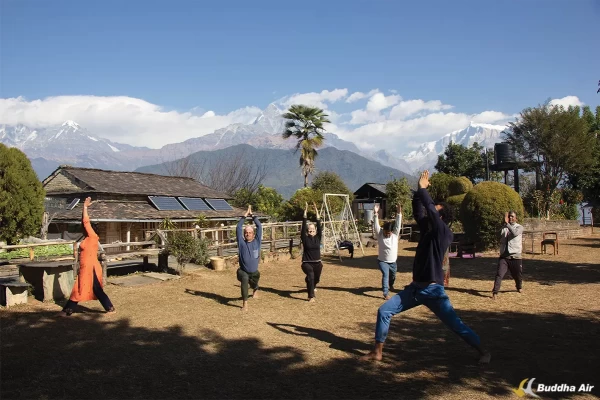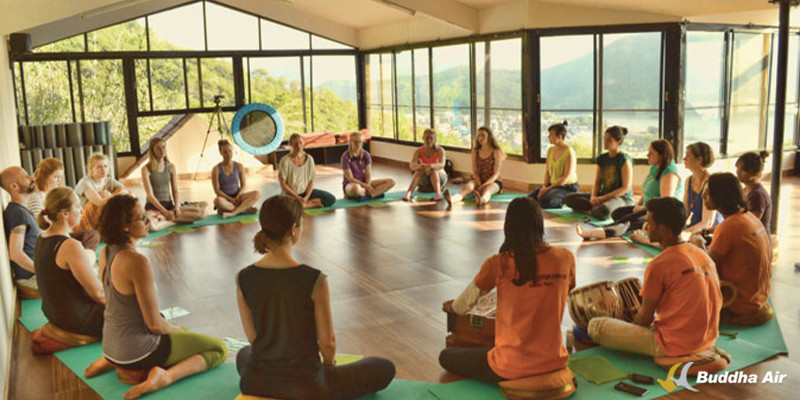Meditation in the Himalayas You Must Experience in Nepal

In today's fast-paced world, stress has become an unavoidable part of life-whether from work, family, or daily responsibilities. Many of us long for a break, an opportunity to unwind and recharge. Travel not only brings new experiences and knowledge but also serves as a powerful stress reliever. When combined with yoga and meditation, it becomes a profoundly rejuvenating journey. It is why yoga tourism is flourishing in Pokhara, offering travelers a perfect blend of relaxation, self-discovery, and natural beauty.
A healthy body and mind are universal desires. Stress levels inevitably rise as individuals take on new challenges in life and careers. True happiness comes from a stress-free mind, yet a life without stress seems like an unattainable ideal. This is where spirituality comes in. Spirituality is said to be the true source of happiness, and those who understand this seek solace in yoga and meditation.
According to studies, around three billion people worldwide suffer from some level of depression. Every 40 seconds, someone falls into depression, and in Nepal alone, two people succumb to it daily. Even in a developed country like the USA, nearly 25% of the population—over 80 million people—struggle with some form of depression.
Depression is a consequence of modernity, machinery, and a money-centered mindset. Meditation is the ultimate remedy, so the demand for meditation classes is increasing worldwide. People seek the ideal place to meditate and free themselves from everyday burdens.
Seeking Spirituality in Yoga Tourism
The number of spiritual tourists in Nepal is on the rise. Trekking tours now incorporate yoga and meditation, making yoga trekking increasingly popular in the Pokhara region. Alongside porters and guides, yoga instructors accompany these treks, leading yoga and meditation sessions at resting points and scenic locations.
Tourists experience deep joy and serenity while practicing yoga in the glow of the Annapurna, Dhaulagiri, and Machhapuchhre mountains. Yoga tourism involves physical and mental exercises, including stretching, fitness training, and meditation. Nepal’s unique traditions, customs, and culture are crucial in enhancing the yoga tourism experience.
Skilled instructors go beyond teaching yoga and meditation—they guide participants on holistic living, covering aspects such as diet, posture, and sleep. These lessons occur in natural settings, with meditation retreats often conducted in serene forest areas, where participants receive pure, sattvic meals to complement their practice.
Tourism professionals note that most foreign visitors attending yoga retreats are women, who tend to be more conscious about physical well-being. Yoga instructor Deepa Basnet shares, “Yoga acts as a remedy for depression and mental anxiety, which is why more women are drawn to it.”
Pokhara—A Sanctuary of Peace amidst the Mountains

With its stunning natural beauty, Pokhara is a natural meditation center. The breathtaking views of mountains, lakes, the Seti River, monasteries, and temples have made it a meditation and yoga tourism hub. The commercial introduction of yoga tourism in Pokhara dates back to 1998 when Amar Puri from Kathmandu established the ‘Sadhana Yoga Retreat’ in Sedidanda. Today, around 15 yoga retreat centers operate in Pokhara.
Yoga tourism is now a well-established sector within Pokhara’s tourism industry. Many hotels have incorporated yoga activities into their services. From January 1, 2025, Hotel Dashain, located on Street No. 13, has dedicated an entire floor to a yoga studio. Kshitiz Pahari and Pratibha Chalise led this initiative.
Pokhara is already a beautiful tourist destination. If promoted as Yoga Land, it could attract spiritual tourists from around the world.
Anna Suvorova
Yoga Instructor, Annapurna Eco Village, Astam
“Previously, hotels only sold rooms and food,” says tourism expert Dipendra Pahari. “Most tourist hotels have added yoga and meditation to their offerings.” Morning meditation sessions are conducted within hotel premises or at scenic natural spots, while evening yoga classes provide further relaxation. Additionally, hotels are increasingly offering organic food options on their menus. Yoga is more than just a tourism product; it should be part of everyone’s daily routine. Pahari emphasizes the need for yoga and meditation to be incorporated into educational curricula, from schools to universities.
Moreover, tour guides serving as tourism ambassadors should have a foundational knowledge of yoga. Pahari suggests making yoga training mandatory for tour guides. “Even experienced guides should be trained. Attracting more spiritual tourists would significantly benefit Nepal.”
The global spread of yoga is credited to Hindu sages, while the expansion of meditation is attributed to Buddhist monks. Destinations like Rishikesh in India and Bali in Indonesia have become leading centers for yoga tourism. Nepal, deeply rooted in Eastern philosophy, has the potential to emerge as an unparalleled yoga destination.
